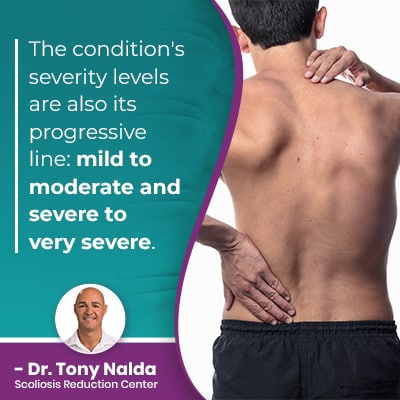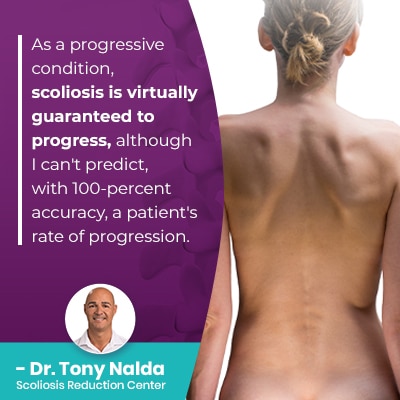What Will Happen If Scoliosis Isn't Treated? [ANSWERED]
![What Will Happen If Scoliosis Isn't Treated? [ANSWERED]](https://drtonynalda.com/wp-content/uploads/2023/09/What-Will-Happen-If-Scoliosis-Isnt-Treated-ANSWERED.jpg)
Scoliosis is a highly-prevalent spinal condition that involves the development of an unnatural spinal curve that bends to the side and also twists, making it a complex 3-dimensional condition. Scoliosis is also progressive, so if left untreated, it's virtually guaranteed to get worse; the sooner treatment is started, the better. There is no way to cure scoliosis, but when addressed proactively, it can be highly treatable.
As a progressive condition, scoliosis has it in its nature to worsen over time, so if scoliosis is left untreated, it's virtually guaranteed to progress. Scoliosis progression means the scoliotic curve is increasing in size, as are the condition's effects, making the spine more rigid, and the condition more complex to treat.
One of the most important decisions scoliosis patients have to make is how to treat scoliosis moving forward.
Table of Contents
Diagnosing Scoliosis
Being diagnosed with scoliosis means an unnatural sideways spinal curve has developed, and this introduces a lot of uneven forces to the spine, its surrounding muscles and nerves, and the body in general.
Scoliosis is also a 3-dimensional spinal condition because the spine doesn't just bend unnaturally to the side, but also twists from front to back, back to front.
While there are never treatment guarantees, scoliosis that's detected early has higher chances of treatment success, and this is related to the condition's progressive nature; being diagnosed with scoliosis also means being diagnosed with a progressive condition.
Scoliosis is Progressive
Scoliosis has it in its nature to worsen over time, meaning as a progressive condition, it's incurable, but it can be highly treatable, particularly if early detection is achieved and responded to with a proactive treatment plan started as close to the time of diagnosis as possible.
 The condition's severity levels are also its progressive line: mild to moderate and severe to very severe.
The condition's severity levels are also its progressive line: mild to moderate and severe to very severe.
Condition severity is determined by a measurement known as Cobb angle, determined during X-ray by drawing lines from the tops and bottoms of the curve's most-tilted vertebrae, and the resulting angle is expressed in degrees:
- Mild scoliosis: Cobb angle measurement of between 10 and 25 degrees
- Moderate scoliosis: Cobb angle measurement of between 25 and 40 degrees
- Severe scoliosis: Cobb angle measurement of 40+ degrees
- Very-severe scoliosis: Cobb angle measurement of 80+ degrees
So where a scoliosis is at the time of diagnosis is not indicative of where it will stay, which is why untreated scoliosis can become severe and/or very severe over time.
For a complete understanding of what happens if scoliosis is left untreated, let's take a look at the different severity levels and how the condition's effects increase alongside progression.
Mild Scoliosis
Mild scoliosis is the first stop on the condition's progressive line, and with a Cobb angle of between 10 and 25 degrees, these curves are small and can be highly treatable.
Mild scoliosis can be hard to detect, especially in children for whom the condition is not yet compressive; scoliosis becomes a compressive condition once skeletal maturity has been reached, and compression of the spine and its surrounding muscles and nerves is the main cause of condition-related pain.
The earliest signs of scoliosis in children are often uneven shoulders and hips, and when mild, even the postural changes associated with scoliosis can be difficult for anyone, other than a trained specialist, to notice.
So while most patients diagnosed with mild scoliosis won't be feeling fortunate, catching it while still mild can have significant treatment benefits, and isn't always easy to do.
Basically, if mild scoliosis is left untreated, the next stop on the progressive line is moderate scoliosis, when the condition's signs and effects tend to become more noticeable.
Moderate Scoliosis
Here at the Scoliosis Reduction Center, most of my patients have moderate scoliosis, and this is because it's common that condition signs and effects only become noticeable after the condition has progressed from mild to moderate, so scoliosis is commonly diagnosed when moderate.
In addition to uneven shoulders and hips, postural changes to watch for can include:
- Uneven shoulder blades
- The development of a rib arch
- An uneven waist line
- Arms and legs that appear to hang at different lengths
When a patient has progressed from mild to moderate, the signs become more noticeable, and additional effects to watch for are changes to balance, coordination, gait, and clothing suddenly seeming ill-fitting.
If moderate scoliosis is left untreated, it's likely to become severe, at some point, and while we don't know what causes the majority of scoliosis cases to develop, we do understand what triggers them to progress: growth and development.
So children who are still growing are at a higher risk for continued progression because of the constant trigger of growth, and for the condition's most common type, adolescent idiopathic scoliosis, diagnosed between the ages of 10 and 18, due to puberty, this age group is at risk for rapid-phase progression (rapid and unpredictable growth spurts during puberty).
Severe Scoliosis
 As a progressive condition, scoliosis is virtually guaranteed to progress, although I can't predict, with 100-percent accuracy, a patient's rate of progression.
As a progressive condition, scoliosis is virtually guaranteed to progress, although I can't predict, with 100-percent accuracy, a patient's rate of progression.
Even adults who have stopped growing will still progress, although typically at a slower rate because the trigger of growth has been removed.
Once a condition has become severe, its effects are noticeable, and for adults, scoliosis can be painful at this level because the size of the unnatural spinal curve is large, and the condition's uneven forces being exposed to the body have increased, as have the condition's effects.
At the severe level, pain can be an issue, both back pain and related muscle pain, and headaches can also become an issue, as can complications such as breathing problems and digestive issues.
The more severe a condition is, the more likely it is to continue progressing, and the more likely it is that related complications can develop.
At the severe level, this is when patients can become surgical candidates, if they are following a traditional treatment approach, and since we've explored the condition's progressive line, let's now move on to the importance of treating scoliosis proactively.
Proactive Treatment and Scoliosis
When it comes time to commit to a scoliosis treatment plan, this is the most important decision patients are faced with; this is because different treatment approaches offer patients different potential outcomes that can affect overall quality of life.
Traditional scoliosis treatment is more reactive than proactive, and this is because it doesn't have a strategy for treating scoliosis while mild, so waits until it progresses into the severe classification, when patients become surgical candidates; then they are funnelled towards spinal fusion surgery.
Now, spinal fusion surgery can successfully stop a condition from progressing, but the way it does so, by fusing multiple vertebrae together and attaching rods to the spine with screws to hold it in place, is contrary to the spine's natural movement-based design.
Many patients are disappointed with the loss in spinal flexibility and range of motion they experience post-surgery, and the reality is that many cases of scoliosis don't need surgery and can be treated successfully without all the associated risks of spinal fusion.
Here at the Center, I treat my patients using a conservative chiropractic-centered treatment approachthat values being proactive by starting treatment as close to the time of diagnosis as possible.
While I can never give treatment guarantees, treatment that's started earlier in a condition's progressive line is more likely to respond positively; as scoliosis progresses, the spine gets more rigid, making it less responsive to treatment, and making it difficult for some patients to perform certain therapeutic exercises as part of treatment.
In addition, over time, the body can adjust to the presence of the unnatural spinal curve, making it more difficult to reverse its effects.
Here at the Center, I integrate multiple different types of treatment so conditions can be impacted on every level: condition-specific chiropractic care, physical therapy, corrective bracing, and rehabilitation.
As a structural condition, scoliosis has to, first and foremost, be impacted on a structural level, and I work towards this through a series of chiropractic techniques and manual adjustments that can adjust the position of the most-tilted vertebrae and realign the spine.
Once I start to see structural results in the form of a curvature reduction, I can shift the focus to increasing core strength so the spine is optimally supported by its surrounding muscles.
Physical therapy and scoliosis-specific exercises can also help improve posture, address any related muscle imbalance, and activate specific areas of the brain for improved brain-body communication.
Corrective bracing can be particularly effective on growing spines so is a regular facet of treating adolescent idiopathic scoliosis; it helps by pushing the spine into a corrective position.
Rehabilitation involves a series of custom-prescribed home exercises to further stabilize and heal the spine for long-term sustainable treatment results.
Conclusion
Each case of scoliosis is unique, which is why the complex nature of the condition necessitates the customization of effective treatment plans.
While I can't always determine how fast, or slowly, a condition will progress, as a progressive condition, progression is virtually guaranteed to occur at some point.
If scoliosis is left untreated, its nature is to get worse, and the worse it gets, the more uneven forces are introduced to the body, the more noticeable the condition's effects are likely to be, the more likely it is that complications will develop, and the more likely it is that invasive surgical treatment will be needed in the future.
The best time to start scoliosis treatment is always now because the more a condition progresses, the more complex it gets to treat; it's far more effective to proactively work towards preventing progression and increasing condition-effects, than it is to attempt to reverse those effects once they're established.
So if you, or someone you care about, has been recently diagnosed with scoliosis, don't hesitate to reach out for guidance and support to ensure the appropriate course of treatment is chosen.
Dr. Tony Nalda
DOCTOR OF CHIROPRACTIC
After receiving an undergraduate degree in psychology and his Doctorate of Chiropractic from Life University, Dr. Nalda settled in Celebration, Florida and proceeded to build one of Central Florida’s most successful chiropractic clinics.
His experience with patients suffering from scoliosis, and the confusion and frustration they faced, led him to seek a specialty in scoliosis care. In 2006 he completed his Intensive Care Certification from CLEAR Institute, a leading scoliosis educational and certification center.
About Dr. Tony Nalda
 Ready to explore scoliosis treatment? Contact Us Now
Ready to explore scoliosis treatment? Contact Us Now





